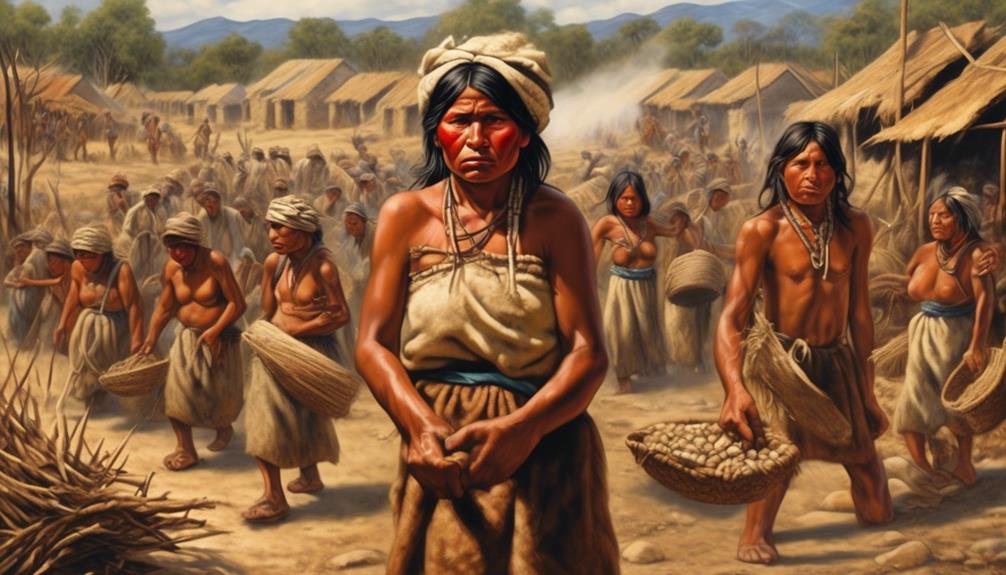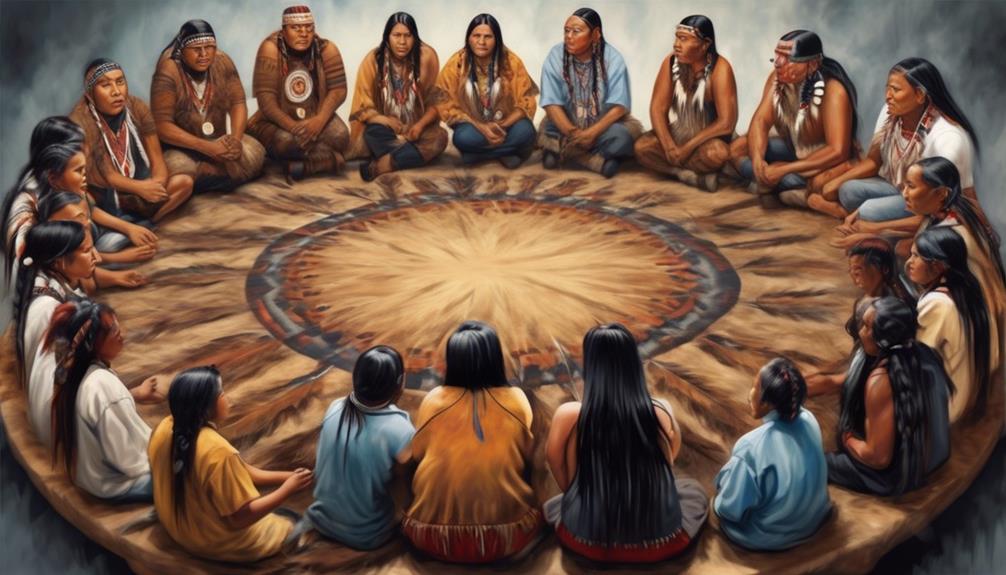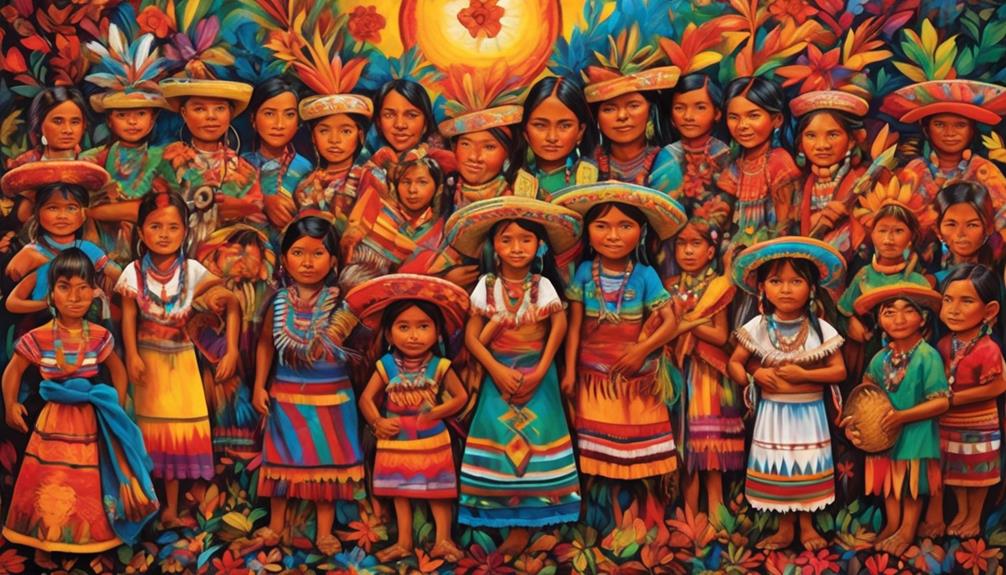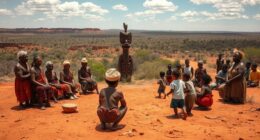Let’s discuss how life was like for indigenous populations during the encomienda system.
The encomienda, a brilliant idea concocted by the Spanish during their conquest of the Americas, was meant to be a benevolent arrangement to care for the indigenous people. However, as we'll soon discover, the reality was far from benevolent.
The impact on indigenous communities, the exploitation and forced labor, the resistance and revolt – these are just a few of the facets we'll explore to understand the complex and often harrowing experience of indigenous populations under the encomienda.
Key Takeaways
- The Encomienda system had a profound impact on indigenous communities, disrupting their social structures, cultural practices, and eroding their cultural identity.
- Indigenous populations were subjected to forced labor in grueling conditions, leading to economic devastation, material deprivation, and the stripping of their autonomy and dignity.
- Despite the hardships, indigenous groups resisted through guerrilla warfare, organized revolts, and acts of cultural preservation and defiance, demonstrating their indomitable spirit and determination.
- The legacy of the Encomienda system includes long-lasting trauma and distrust towards authorities, intergenerational socioeconomic disparities, efforts to revitalize indigenous languages and art forms, and cultural syncretism and adaptation.
Origins of the Encomienda System
The origins of the Encomienda System can be traced back to the early years of Spanish colonization in the Americas. Spanish colonization brought with it a system of land ownership that was vastly different from the communal land use practiced by the indigenous populations. The encomienda, initially intended as a means to protect and convert indigenous peoples, was soon exploited by the Spanish conquistadors for economic gains.
The system granted Spanish settlers the right to extract forced labor and tribute from the indigenous communities in exchange for protection and religious instruction. This led to widespread abuse and exploitation, as the land and its inhabitants were treated as commodities. The concept of land ownership was fundamentally altered, imposing a foreign system upon cultures with vastly different beliefs and practices.
The consequences of this imposition reverberated through generations, shaping the social and economic landscape of the Americas. Understanding the origins of the Encomienda System provides crucial insight into the complex dynamics of power, exploitation, and cultural clashes that defined this period in history.
Impact on Indigenous Communities
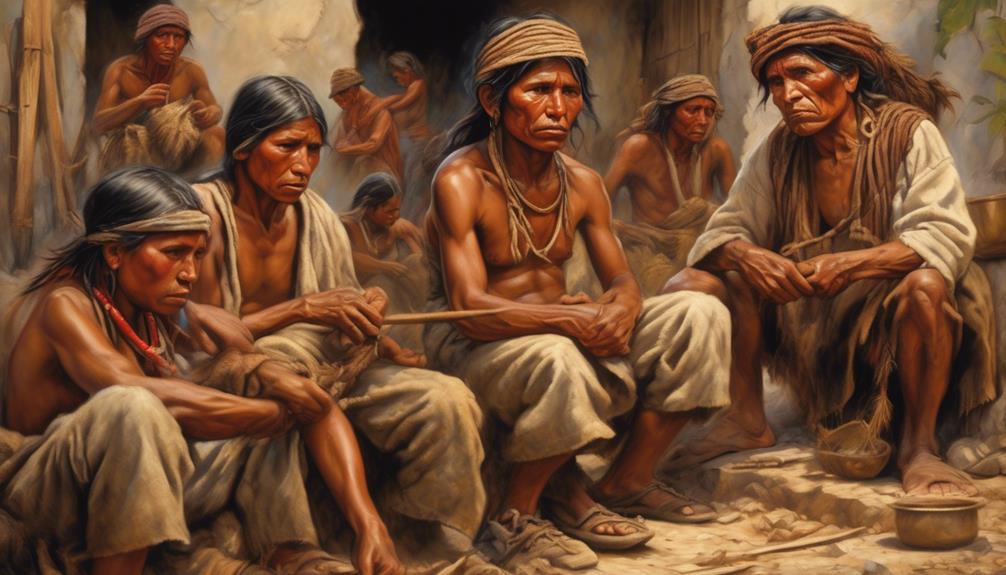
Having endured centuries of exploitation, indigenous communities across the Americas faced enduring repercussions from the Encomienda System. The impact on indigenous communities was profound, resulting in widespread cultural assimilation and economic devastation.
The Encomienda System disrupted the traditional social structures and cultural practices of indigenous populations, leading to the erosion of their cultural identity. Forced labor and exploitation under the encomenderos often resulted in the loss of indigenous languages, customs, and traditions. This cultural assimilation was a direct consequence of the Encomienda System's oppressive nature, which aimed to subjugate and control indigenous communities for the benefit of the Spanish colonizers.
Moreover, the economic devastation caused by the Encomienda System had long-lasting effects on indigenous communities. The exploitation of indigenous labor and resources led to economic disparity, impoverishment, and the disruption of traditional economic systems. This not only resulted in material deprivation but also contributed to social and psychological trauma within indigenous communities.
The repercussions of the Encomienda System were far-reaching, leaving a legacy of cultural and economic hardship that continued to affect indigenous populations for generations.
Exploitation and Forced Labor
Exploiting the labor and resources of indigenous populations, the Encomienda System perpetuated a cycle of oppression and suffering that deeply impacted their communities. Forced labor was a central aspect of this system, as indigenous individuals were compelled to work in grueling conditions, often with little to no compensation. The cultural oppression experienced by indigenous populations under the Encomienda System can't be overstated. Their traditional practices and beliefs were disregarded, and they were forced to adopt the customs and religion of the colonizers.
The forced labor imposed on indigenous communities not only resulted in physical hardship but also had profound psychological and social repercussions. Families were torn apart as individuals were conscripted to toil in the encomendero's fields or mines, disrupting the social fabric of indigenous societies. This exploitation stripped indigenous peoples of their autonomy and dignity, subjecting them to a life of servitude and hardship.
The legacy of forced labor and cultural oppression endured by indigenous populations under the Encomienda System continues to reverberate through generations, shaping the complex socio-economic landscape of many regions today. Understanding this historical context is crucial for comprehending the challenges faced by indigenous communities and working towards a more equitable future.
Resistance and Revolt
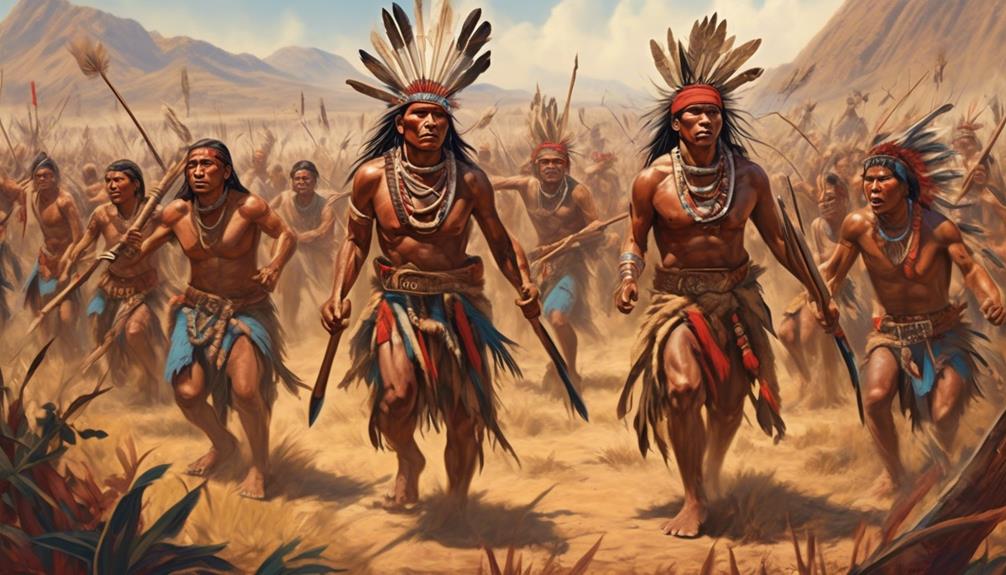
Despite the overwhelming challenges and oppression, indigenous communities displayed remarkable resilience and courage in their resistance against the Encomienda System. Their acts of defiance and revolt weren't only a testament to their unwavering spirit but also crucial in shaping the course of history. Here's a closer look at their resistance:
- Guerrilla Warfare: Indigenous groups engaged in guerrilla warfare, utilizing their knowledge of the land to launch surprise attacks, ambushes, and hit-and-run tactics against the encomenderos and colonial forces. This form of resistance not only disrupted the exploitative labor practices but also instilled fear and uncertainty among the oppressors.
- Revolt and Uprisings: Various indigenous communities organized revolts and uprisings, often led by influential leaders who rallied their people to reclaim their autonomy and freedom. These acts of defiance were powerful demonstrations of indigenous empowerment and solidarity against colonial oppression.
- Cultural Preservation: In addition to overt acts of resistance, indigenous communities also preserved their cultural practices and traditions, which served as a form of resistance against the forced assimilation efforts of the encomenderos. This cultural resilience was a subtle yet potent form of resistance, reinforcing the identity and strength of indigenous populations.
The resistance and revolt of indigenous communities under the Encomienda System exemplify the indomitable spirit and determination of marginalized groups in the face of systemic oppression.
Legacy and Aftermath
The resilience and defiance displayed by indigenous communities in their resistance against the Encomienda System have left a lasting legacy that continues to shape the aftermath of this tumultuous period in history. The legacy effects of the Encomienda System are deeply intertwined with the cultural preservation efforts of indigenous populations. Despite enduring immense suffering, indigenous communities have persistently strived to safeguard their traditions, languages, and ways of life, thereby preserving their cultural heritage for future generations. This unwavering commitment to cultural preservation serves as a testament to the enduring strength and resilience of indigenous peoples.
| Legacy Effects | Cultural Preservation | Aftermath Impact |
|---|---|---|
| Long-lasting trauma and distrust towards authorities | Preservation of traditional practices, rituals, and knowledge | Shaping contemporary indigenous rights movements |
| Intergenerational socioeconomic disparities | Efforts to revitalize indigenous languages and art forms | Influence on land rights and resource management policies |
| Cultural syncretism and adaptation | Establishment of community-led educational initiatives | Formation of transnational indigenous networks and alliances |
The aftermath of the Encomienda System reverberates through the present day, as indigenous communities continue to grapple with the enduring impacts while simultaneously demonstrating remarkable strength in their cultural preservation efforts.
Frequently Asked Questions
How Did the Encomienda System Impact the Traditional Social and Political Structures of Indigenous Communities?
The encomienda system deeply impacted indigenous communities, disrupting traditional social and political structures. It resulted in the exploitation and forced labor of indigenous people, leading to the breakdown of their societal norms and governance.
This had devastating effects on their cultural identity and autonomy. The encomienda system's impact on communities was profound, causing significant upheaval in social hierarchies and political organization, ultimately leaving lasting scars on indigenous societies.
What Were the Long-Term Effects of the Encomienda System on Indigenous Cultures and Languages?
The encomienda system had a profound impact on indigenous cultures and languages. Cultural assimilation occurred as the Spanish influence eroded traditional practices, affecting language use and cultural identity.
The long-term effects of this system were detrimental, leading to a loss of linguistic diversity and traditional knowledge. Indigenous communities faced significant challenges in preserving their languages and cultural heritage in the face of such assimilation.
Were There Any Efforts Made by the Spanish Authorities to Regulate and Improve the Treatment of Indigenous Populations Under the Encomienda System?
We can't emphasize enough the profound impact of Spanish regulation on the treatment of indigenous populations. Encomienda's influence on social structures and political changes can't be overstated.
Spanish authorities made efforts to improve indigenous treatment, but these were often insufficient. The system's exploitative nature perpetuated significant suffering. Despite some attempts to regulate, the overall impact was detrimental.
The consequences echo through history, underscoring the need for a comprehensive understanding of this complex issue.
How Did the Encomenderos Justify Their Treatment of Indigenous People and Exploitation of Their Labor?
Encomenderos justified their treatment of indigenous people and exploitation of their labor by claiming it was part of their duty to 'civilize' and Christianize the indigenous population. They viewed themselves as benevolent protectors, but in reality, they often imposed harsh working conditions and forced labor, causing immense suffering.
The encomienda system was a tool for exploitation, leading to the suffering and decline of indigenous populations, all under the guise of supposed 'civilizing' efforts.
What Role Did Indigenous Leaders and Religious Figures Play in Resisting the Encomienda System and Advocating for the Rights of Their Communities?
Indigenous resistance against the encomienda system was crucial for preserving cultural identity and advocating for community rights.
Leaders and religious figures played a pivotal role in organizing resistance and promoting cultural preservation. They bravely stood against exploitation, mobilizing their communities to resist unjust treatment.
Their advocacy reflected a deep commitment to protecting the rights and dignity of their people.
This resistance was essential for challenging the oppressive encomienda system and reclaiming indigenous autonomy.
Conclusion
In conclusion, life for indigenous populations under the encomienda was like being trapped in a web of exploitation and forced labor, like a bird with clipped wings.
The system had a devastating impact on their communities, leading to resistance and revolt.
The legacy of the encomienda continues to affect indigenous populations to this day, but their resilience and strength in the face of such adversity is a testament to their enduring spirit.
